Santiago Calatrava also celebrates the opening of Qatar Pavilion; delivering two structures to welcome millions of visitors from around the world to the United Arab Emirates’ international event
Santiago Calatrava is pleased to announce the completion of the UAE Pavilion and Qatar Pavilion as part of World Expo 2020 in Dubai, United Arab Emirates (UAE). As the host country’s pavilion, the UAE Pavilion sits at the heart of the nearly 500-acre exhibition area welcoming visitors to the global event, acting as an anchor to the Expo.
“We are honored to unveil the UAE Pavilion at Dubai Expo 2020. The UAE Pavilion’s design emulates a falcon in flight, symbolic to the country, and is rooted in UAE’s local rich history and cultural heritage,” said Santiago Calatrava.
“We are thrilled to unveil the UAE Pavilion to the public. The vision behind this structure took on many forms and challenged us to ensure that the result of the design represented the UAE. The project draws inspiration from the urban fabric from which it rises to serve as an extension of the country,” said Micael Calatrava, CEO of Calatrava International.
UAE Pavilion
Serving as the host country’s pavilion and the anchor for Expo 2020 in the Opportunity District, the UAE Pavilion reveals an immersive experience for guests to discover the UAE’s history and future. The design is inspired by the majestic falcon, the national bird of the United Arab Emirates. Continuing to pay homage to the UAE’s heritage, the Calatrava team drew inspiration from the traditional Bedouin tent, incorporating such elements into the building’s elevation in honor and recognition of life in the desert and the local sustainable solutions associated with it. The sloped geometry of the roof and the floating wings create visual and outward connections that welcome visitors approaching the UAE Pavilion from all directions.
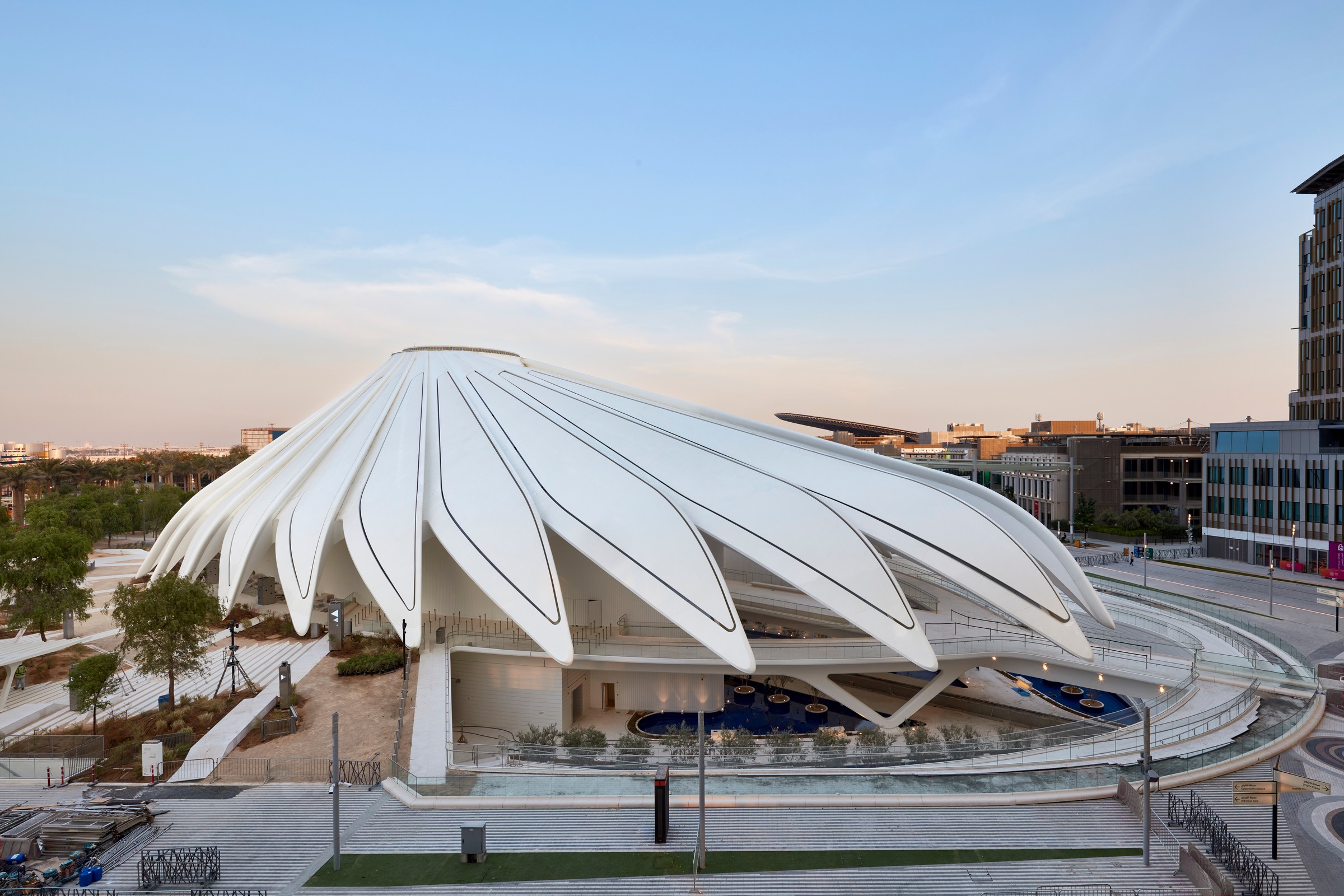
Landscaped spaces surrounding the UAE Pavilion on all sides allow for an effortless flow of pedestrian movement toward the UAE Pavilion, while strategically aligned bridges orient the main entrance toward the heart of the EXPO master plan, the Al Wasl Plaza. The layout of the UAE Pavilion site is inspired by the image of the Aton Sun, providing opportunities for visitors to approach the pavilion from all angles and to allow the surrounding areas of the pavilion to gently integrate with its immediate surroundings.
The Garden at the basement level, which provides access to the lower level of the Pavilion, offers a cool and tranquil environment with large water pools and trees naturally cooling the air, creating shade, and reducing reflected heat, making this space a sunken refuge from direct exposure to the extreme climatic conditions.
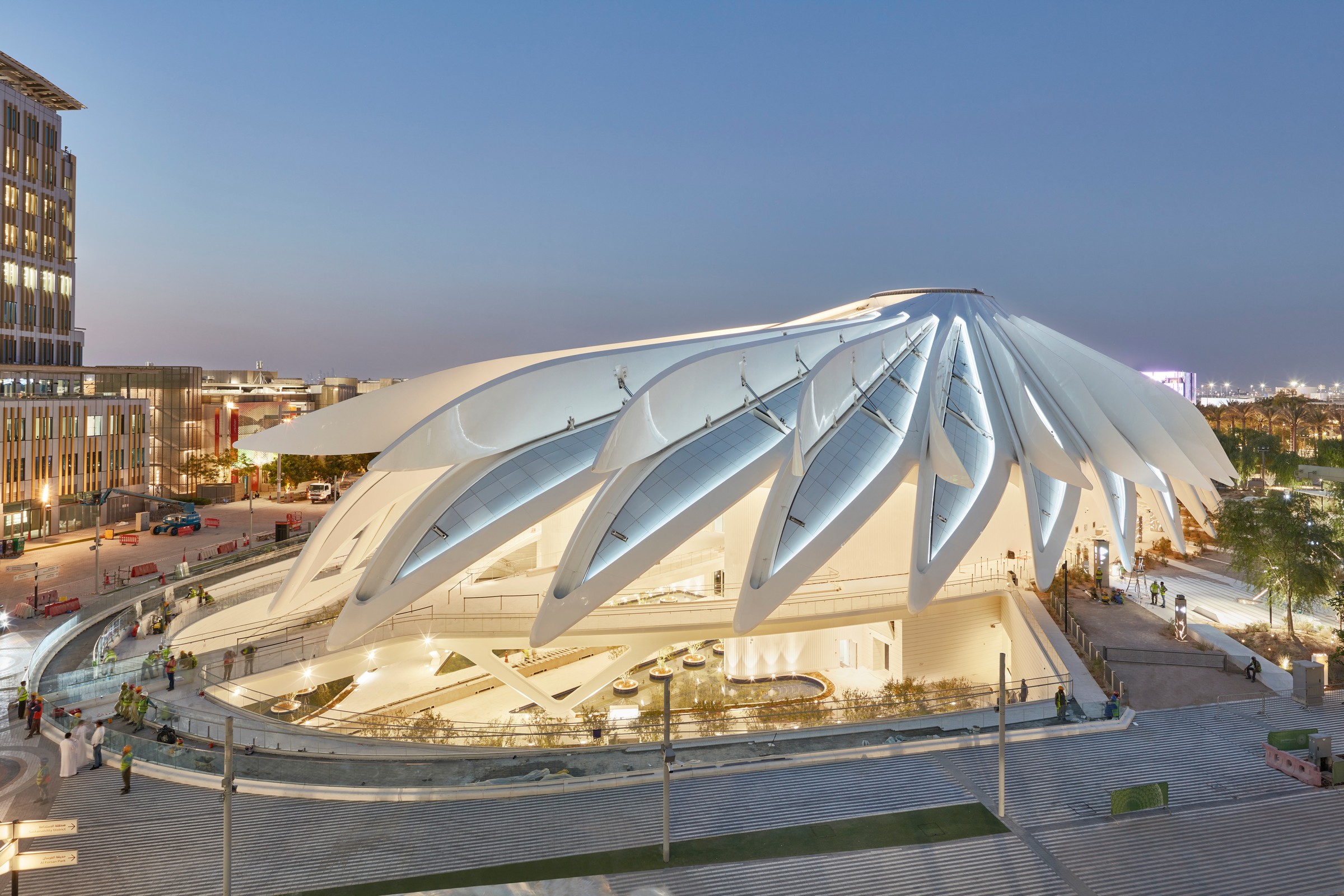
An immersive multi-sensory visitor experience inside the UAE Pavilion guides visitors through the ‘Land of Dreamers Who Do’ through authentic human stories, with the goal of fostering a sense of connectedness, encouraging global and local stakeholders to collaborate with the UAE and invite the world to experience UAE’s story first-hand.
Sustainability is at the heart of the design, which incorporates elements that are energy efficient, reduce water consumption, optimize indoor air quality, include regional materials and native species, and others. The UAE Pavilion is certified LEED Platinum and is compliant with the Dubai Green Building Regulations and Specifications (DGBR). Furthermore, the UAE Pavilion will be repurposed for cultural uses in the country for years to come.
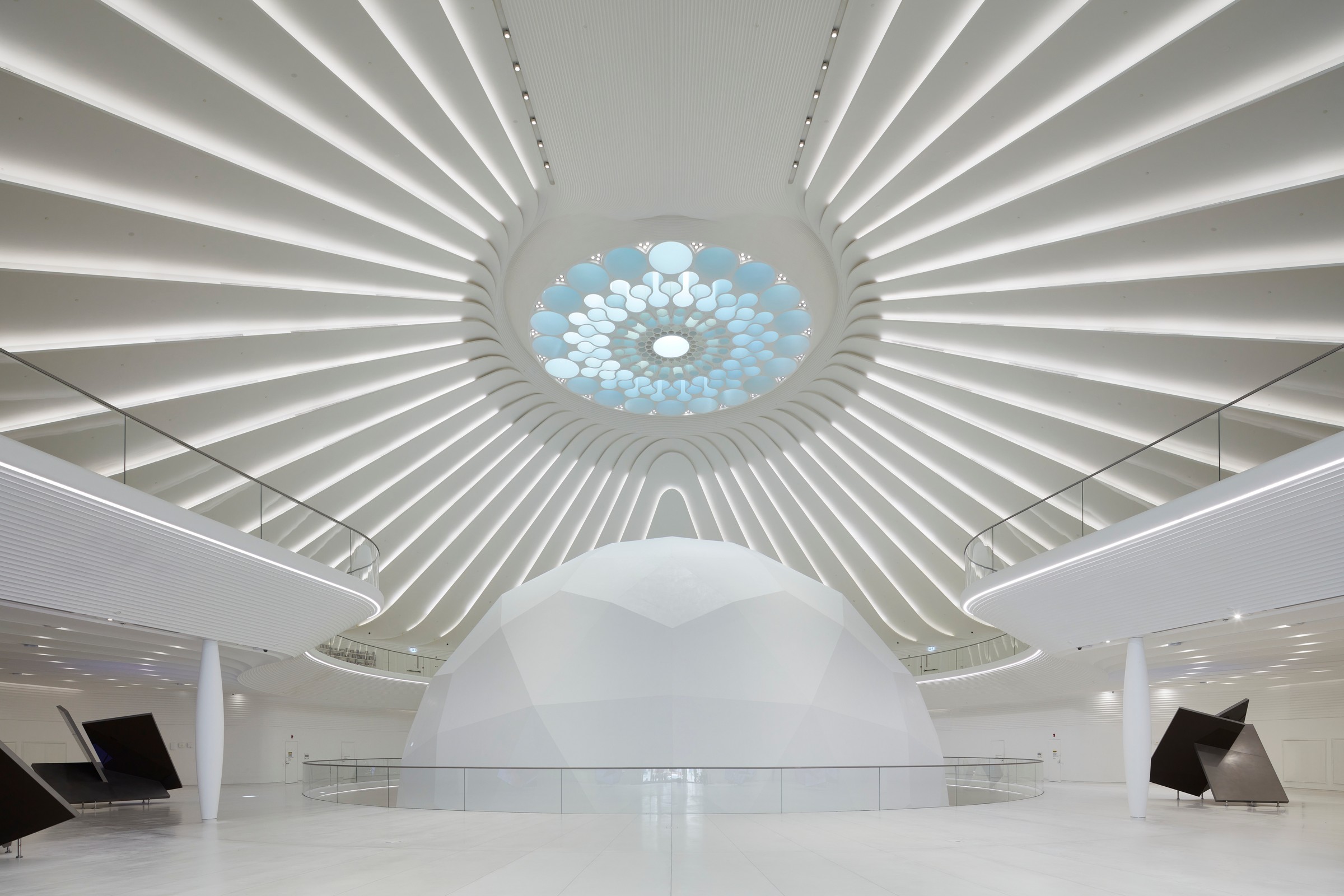
Additional architectural features of the UAE Pavilion include:
● The Pavilion spans across an area of 15,000 meters (over 161,000 square feet) and 27.8 meters in height, the largest Pavilion at Expo 2020.
● An Oculus skylight at the apex of the roof which mirrors the form of the Expo 2020 logo.
● 28 movable ‘wings’ that make up the roof, which can fully open within three minutes, positioning themselves anywhere between 110 and 125 degrees.
● When open, the wings reveal a surface grid of photovoltaic panels. The panels have been designed to absorb the maximum amount of sunlight to harvest energy which is returned to the main power grid. When closed, the wings shelter and protect the photovoltaic panels from rain and sandstorms.
● A sphere shaped, multi-faceted auditorium located in the center, serves as both a centerpiece and functional space with a capacity of 200 people.
● The space displays a symbolic interpretation of the flow of movement through the articulation of carefully planned lines and crafted spaces.
● Landscaped areas with thousands of plants from 12 different species, eight of which are native, as well as over 80 trees, with approximately 45 of the trees holding cultural importance for the UAE.
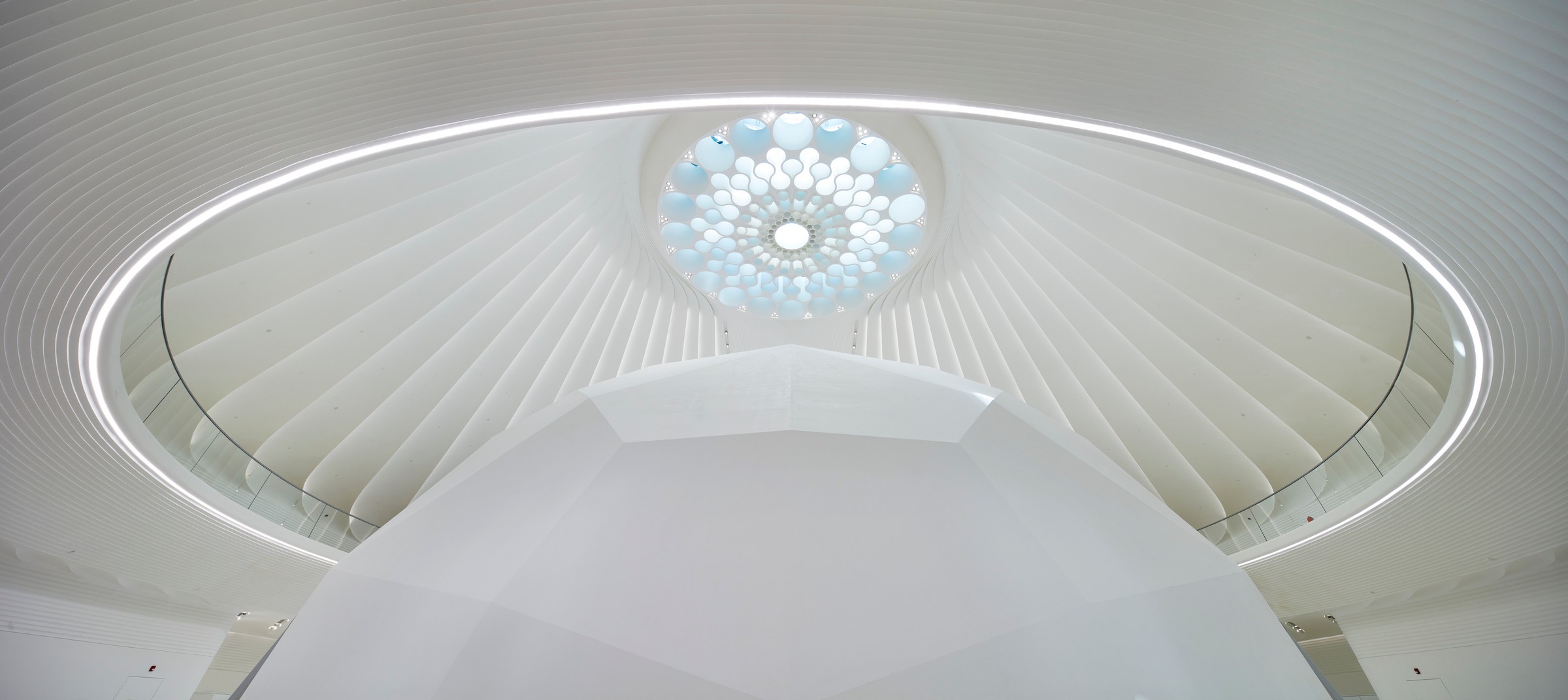
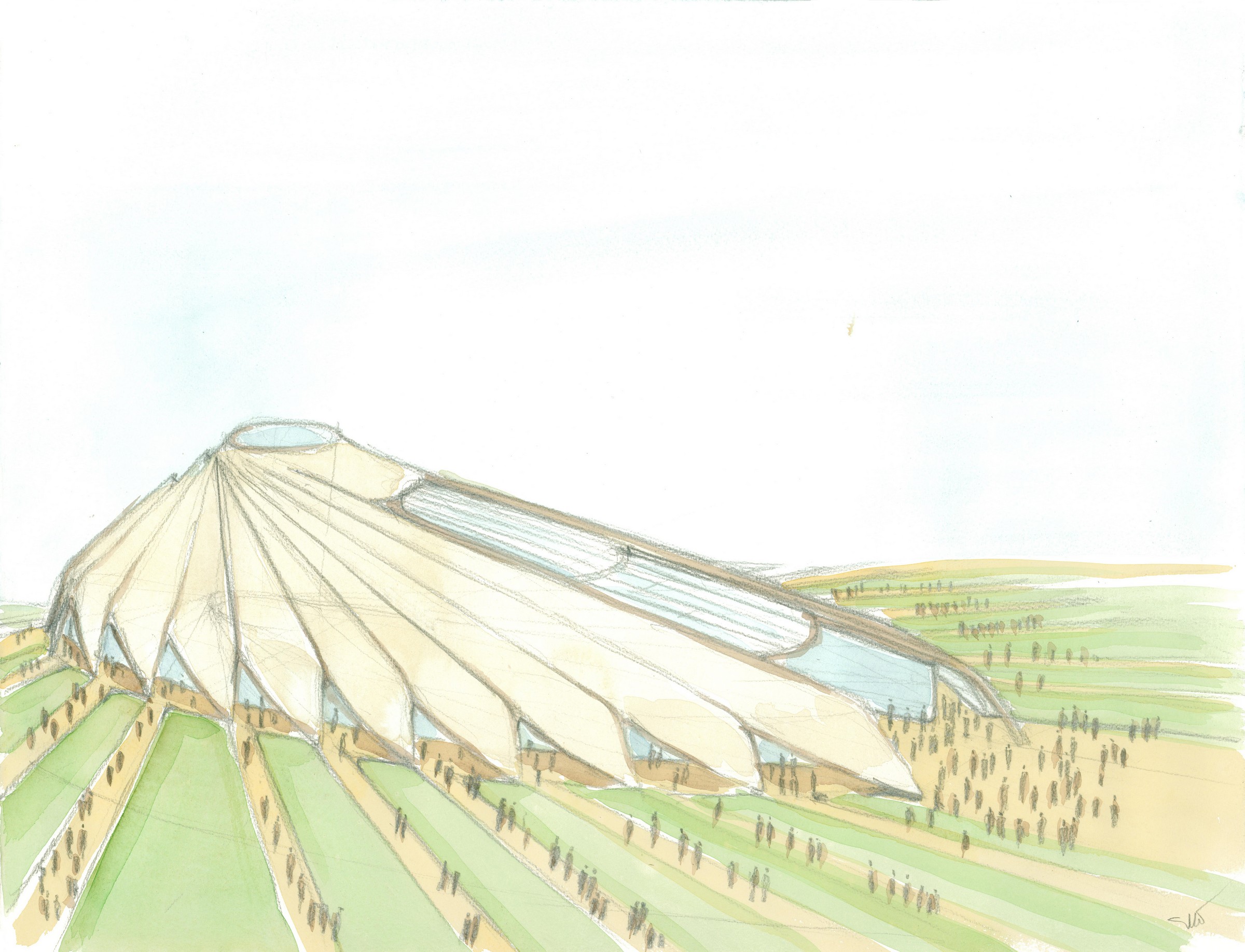
Qatar Pavilion
“The Qatar Pavilion pays tribute to the Coats of Arms of Qatar and captures the country’s tradition, successful present and promising future. We are thrilled to announce its completion and unveil it to the public,” said Santiago Calatrava.
The Qatar Pavilion’s design draws inspiration from the four elements represented on the Coat of Arms of Qatar; two crossed and curved swords, encompassing a Dhow and Island with palm trees. The expressive form of the Pavilion eloquently combines and translates these cultural elements to capture movement, mobility, strength, and tradition.
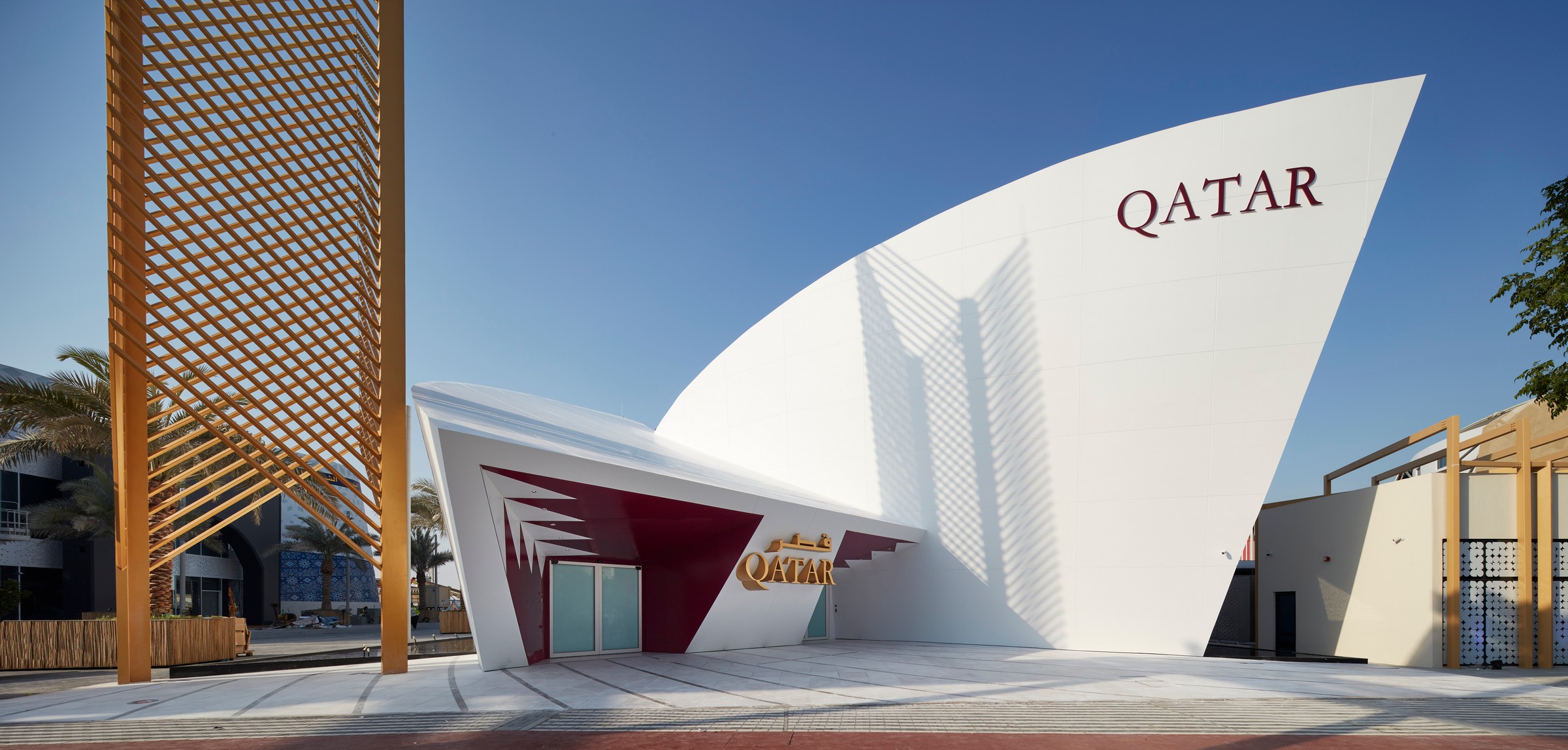
Covering an area of approximately 960 square meters, the Qatar Pavilion accommodates a total built up area (BUA) of approximately 620 square meters. The intersecting structure of the main building ascends upwards to nearly 15 meters in height, with an adjacent sculptural monument rising to 20 meters in height.
The interior of the Qatar Pavilion consists of two main galleries and exhibition spaces, providing highly engaging, inclusive, and experiential environments for visitors. Once visitors enter the Qatar Pavilion, they are guided through an immersive experience that informs them about the past, present and future of Qatar.
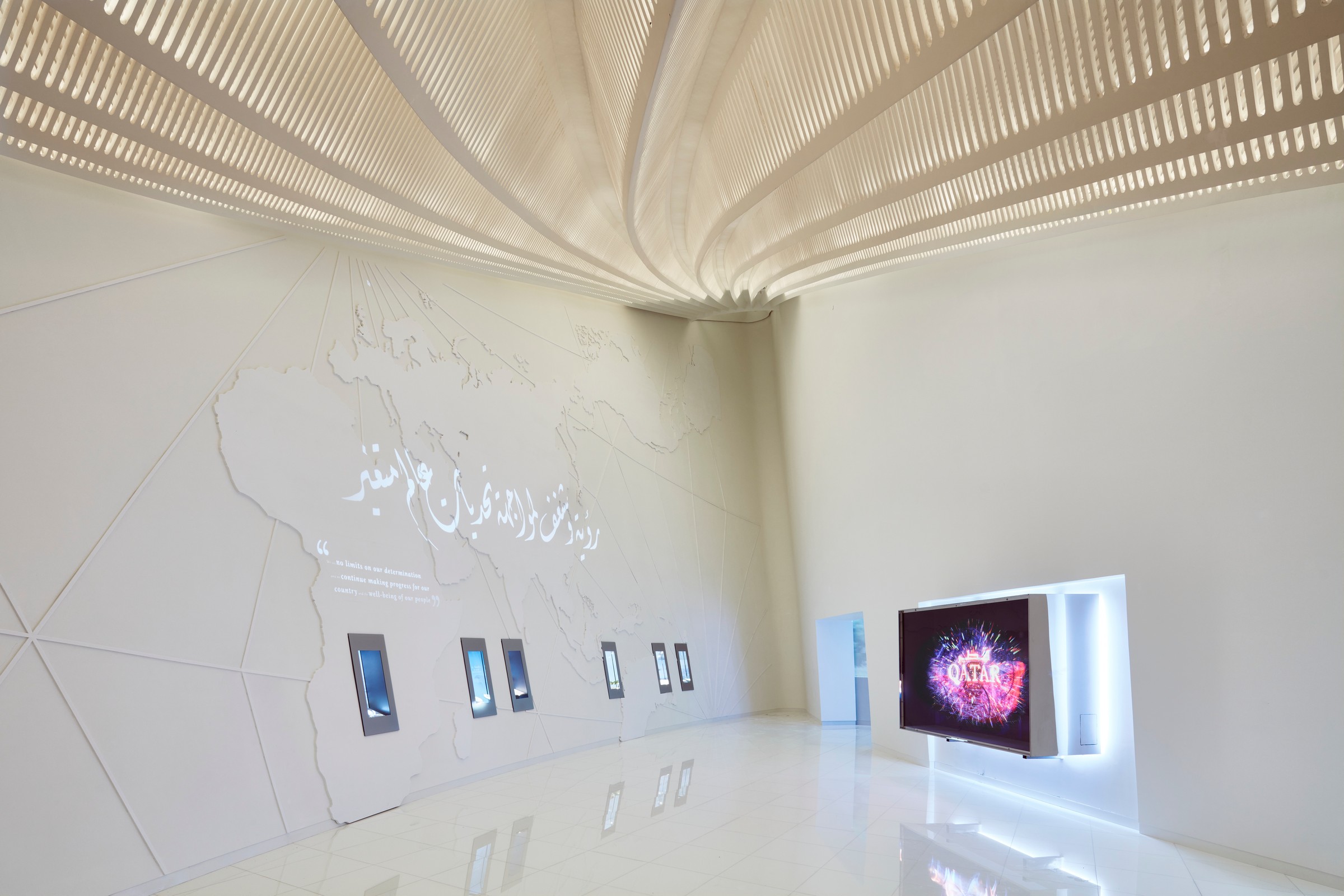
In collaboration with main contractor, ALEC FITOUT, the project’s Engineer of Record, Aurecon, and Omnium, the project’s Contract Managers, the Santiago Calatrava project team applied an integrated design and accelerated construction strategy for the Qatar Pavilion at Expo 2020. The approach follows a non-linear, non-traditional design methodology that ensured an expedited project delivery timeline of just five months.
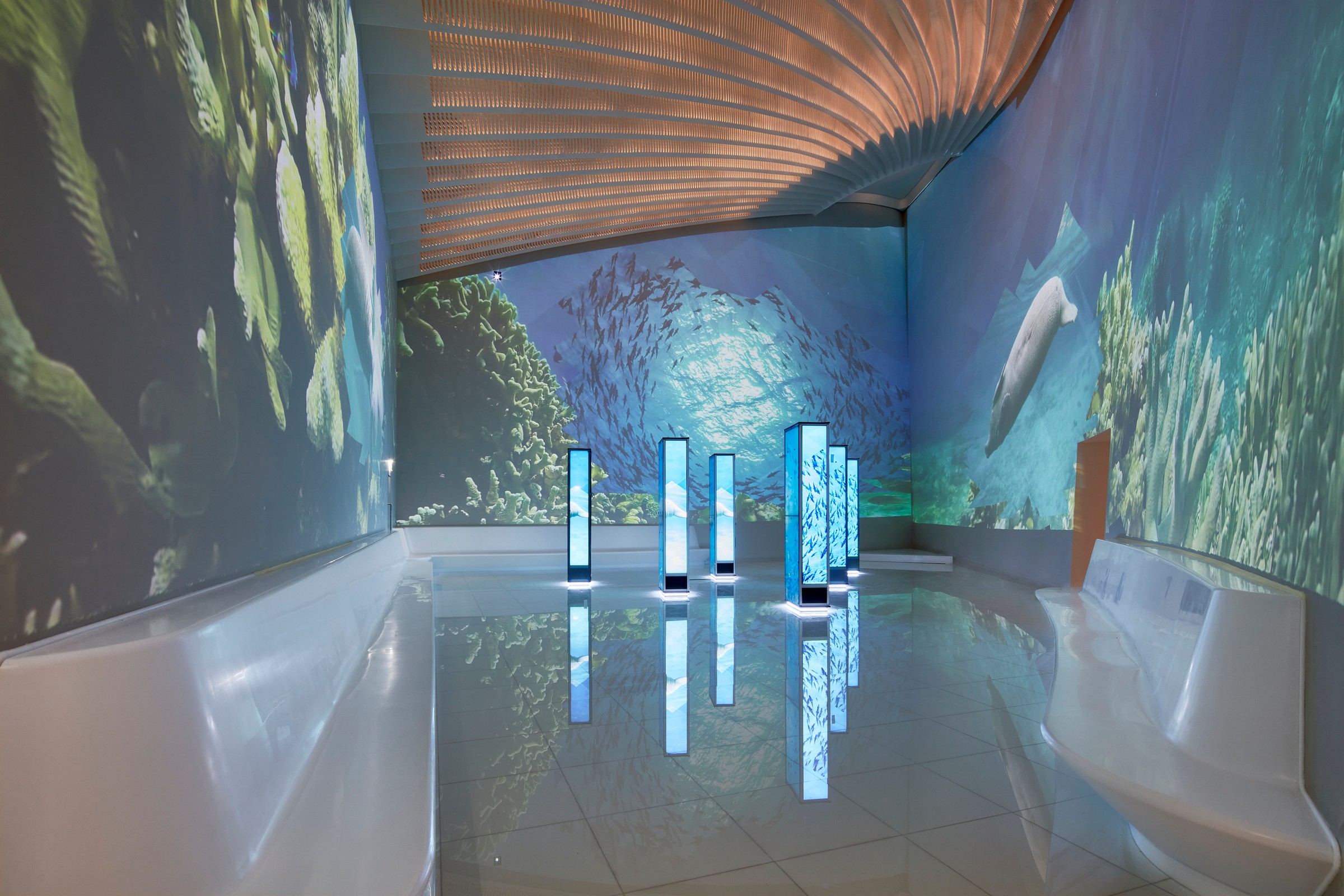
Expo 2020
The Dubai World Expo 2020 is a six-month event showcasing architecture, global culture and innovation that will bring together participants from 180 countries and six continents. It will include over 200 participants, including nations, multilateral organizations, corporations, and educational institutions. The theme of this year’s Expo, “Connecting Minds, Creating the Future,” underscores how the modern world is interconnected and the need to generate sustainable solutions to global problems. The Expo is set to run from October 2021 to March 2022.

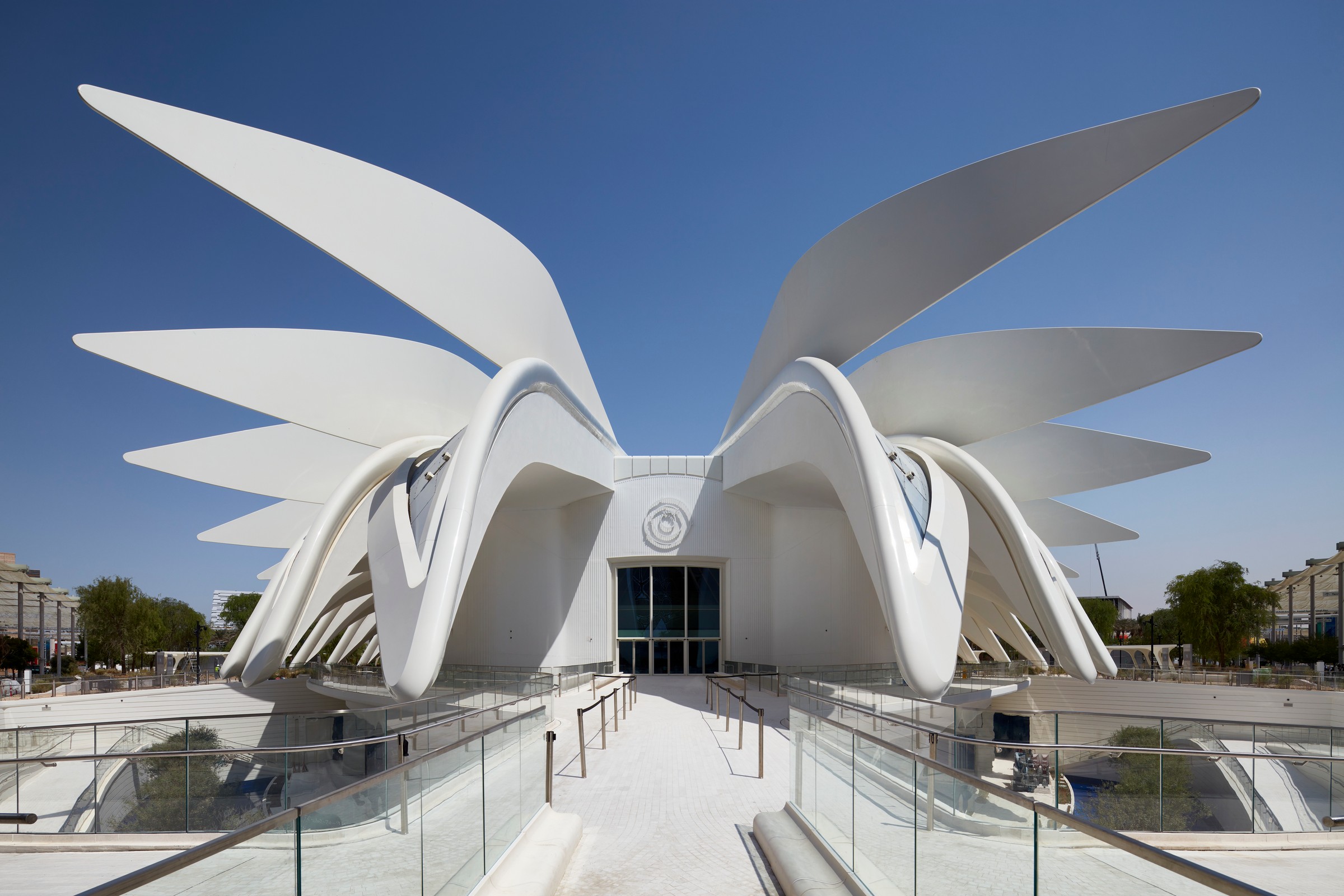





47 Comments
seo services usa chicago
(April 24, 2023 - 4:06 pm)seo services usa chicago
efkkfhvap wlcxb msfxryy gfjk bobfywyxnqwwukw
w88 asia
(April 24, 2023 - 10:17 pm)… [Trackback]
[…] Here you will find 36257 more Information to that Topic: archidust.com/blog/2021/10/11/santiago-calatrava-celebrates-opening-of-uae-pavilion-and-qatar-pavilion-at-expo-2020-dubai/ […]
Investment
(April 25, 2023 - 12:37 am)… [Trackback]
[…] Find More here to that Topic: archidust.com/blog/2021/10/11/santiago-calatrava-celebrates-opening-of-uae-pavilion-and-qatar-pavilion-at-expo-2020-dubai/ […]
buy saxenda online
(April 25, 2023 - 9:46 am)… [Trackback]
[…] Read More Information here to that Topic: archidust.com/blog/2021/10/11/santiago-calatrava-celebrates-opening-of-uae-pavilion-and-qatar-pavilion-at-expo-2020-dubai/ […]
ตู้คอนโทรลสเเตนเลส
(April 25, 2023 - 10:19 pm)… [Trackback]
[…] There you can find 34018 additional Information on that Topic: archidust.com/blog/2021/10/11/santiago-calatrava-celebrates-opening-of-uae-pavilion-and-qatar-pavilion-at-expo-2020-dubai/ […]
mcx spear
(May 8, 2023 - 1:48 am)… [Trackback]
[…] Information on that Topic: archidust.com/blog/2021/10/11/santiago-calatrava-celebrates-opening-of-uae-pavilion-and-qatar-pavilion-at-expo-2020-dubai/ […]
briansclub
(May 8, 2023 - 3:21 am)… [Trackback]
[…] Here you will find 75749 more Information on that Topic: archidust.com/blog/2021/10/11/santiago-calatrava-celebrates-opening-of-uae-pavilion-and-qatar-pavilion-at-expo-2020-dubai/ […]
locksmith Alamogordo NM
(June 11, 2023 - 4:50 pm)… [Trackback]
[…] Information to that Topic: archidust.com/blog/2021/10/11/santiago-calatrava-celebrates-opening-of-uae-pavilion-and-qatar-pavilion-at-expo-2020-dubai/ […]
다시보기 사이트 추천
(June 16, 2023 - 11:21 am)… [Trackback]
[…] Read More here on that Topic: archidust.com/blog/2021/10/11/santiago-calatrava-celebrates-opening-of-uae-pavilion-and-qatar-pavilion-at-expo-2020-dubai/ […]
pico laser
(June 23, 2023 - 10:37 pm)… [Trackback]
[…] Find More here on that Topic: archidust.com/blog/2021/10/11/santiago-calatrava-celebrates-opening-of-uae-pavilion-and-qatar-pavilion-at-expo-2020-dubai/ […]
bergara premier hmr pro
(July 5, 2023 - 12:31 pm)… [Trackback]
[…] Read More to that Topic: archidust.com/blog/2021/10/11/santiago-calatrava-celebrates-opening-of-uae-pavilion-and-qatar-pavilion-at-expo-2020-dubai/ […]
Buy psilocybin mushrooms capsules online australia
(July 7, 2023 - 2:14 am)… [Trackback]
[…] Read More Information here on that Topic: archidust.com/blog/2021/10/11/santiago-calatrava-celebrates-opening-of-uae-pavilion-and-qatar-pavilion-at-expo-2020-dubai/ […]
nagaqq
(July 17, 2023 - 9:13 am)… [Trackback]
[…] Read More to that Topic: archidust.com/blog/2021/10/11/santiago-calatrava-celebrates-opening-of-uae-pavilion-and-qatar-pavilion-at-expo-2020-dubai/ […]
car transport company
(August 3, 2023 - 2:56 am)… [Trackback]
[…] Read More on that Topic: archidust.com/blog/2021/10/11/santiago-calatrava-celebrates-opening-of-uae-pavilion-and-qatar-pavilion-at-expo-2020-dubai/ […]
source
(August 3, 2023 - 10:37 pm)… [Trackback]
[…] Read More to that Topic: archidust.com/blog/2021/10/11/santiago-calatrava-celebrates-opening-of-uae-pavilion-and-qatar-pavilion-at-expo-2020-dubai/ […]
fever club คาสิโน
(August 6, 2023 - 1:05 am)… [Trackback]
[…] Find More on that Topic: archidust.com/blog/2021/10/11/santiago-calatrava-celebrates-opening-of-uae-pavilion-and-qatar-pavilion-at-expo-2020-dubai/ […]
limousine Bangkok airport
(August 6, 2023 - 4:16 am)… [Trackback]
[…] There you can find 83833 additional Information on that Topic: archidust.com/blog/2021/10/11/santiago-calatrava-celebrates-opening-of-uae-pavilion-and-qatar-pavilion-at-expo-2020-dubai/ […]
buy flum float vapes
(August 9, 2023 - 7:56 am)… [Trackback]
[…] Read More on that Topic: archidust.com/blog/2021/10/11/santiago-calatrava-celebrates-opening-of-uae-pavilion-and-qatar-pavilion-at-expo-2020-dubai/ […]
Alpha88
(August 11, 2023 - 11:11 pm)… [Trackback]
[…] Info to that Topic: archidust.com/blog/2021/10/11/santiago-calatrava-celebrates-opening-of-uae-pavilion-and-qatar-pavilion-at-expo-2020-dubai/ […]
alpha88 pc
(August 12, 2023 - 2:11 am)… [Trackback]
[…] Find More here on that Topic: archidust.com/blog/2021/10/11/santiago-calatrava-celebrates-opening-of-uae-pavilion-and-qatar-pavilion-at-expo-2020-dubai/ […]
togel online
(August 14, 2023 - 11:10 am)… [Trackback]
[…] Read More Info here on that Topic: archidust.com/blog/2021/10/11/santiago-calatrava-celebrates-opening-of-uae-pavilion-and-qatar-pavilion-at-expo-2020-dubai/ […]
bonanza178
(August 18, 2023 - 7:31 am)… [Trackback]
[…] Information to that Topic: archidust.com/blog/2021/10/11/santiago-calatrava-celebrates-opening-of-uae-pavilion-and-qatar-pavilion-at-expo-2020-dubai/ […]
สายใยลวด
(August 22, 2023 - 10:24 pm)… [Trackback]
[…] Find More Information here to that Topic: archidust.com/blog/2021/10/11/santiago-calatrava-celebrates-opening-of-uae-pavilion-and-qatar-pavilion-at-expo-2020-dubai/ […]
ทินเนอร์คุณภาพสูง
(August 25, 2023 - 11:52 pm)… [Trackback]
[…] Find More Information here on that Topic: archidust.com/blog/2021/10/11/santiago-calatrava-celebrates-opening-of-uae-pavilion-and-qatar-pavilion-at-expo-2020-dubai/ […]
토렌트 사이트
(August 31, 2023 - 2:11 am)… [Trackback]
[…] Here you will find 57715 additional Info to that Topic: archidust.com/blog/2021/10/11/santiago-calatrava-celebrates-opening-of-uae-pavilion-and-qatar-pavilion-at-expo-2020-dubai/ […]
condo for sale pattaya
(September 2, 2023 - 11:21 pm)… [Trackback]
[…] Find More on on that Topic: archidust.com/blog/2021/10/11/santiago-calatrava-celebrates-opening-of-uae-pavilion-and-qatar-pavilion-at-expo-2020-dubai/ […]
เพิ่มยอดไลค์
(September 9, 2023 - 11:02 pm)… [Trackback]
[…] There you will find 33962 more Information on that Topic: archidust.com/blog/2021/10/11/santiago-calatrava-celebrates-opening-of-uae-pavilion-and-qatar-pavilion-at-expo-2020-dubai/ […]
dmt vape pen
(September 22, 2023 - 9:28 pm)… [Trackback]
[…] Find More Information here on that Topic: archidust.com/blog/2021/10/11/santiago-calatrava-celebrates-opening-of-uae-pavilion-and-qatar-pavilion-at-expo-2020-dubai/ […]
buy oxycodone online
(September 22, 2023 - 9:39 pm)… [Trackback]
[…] Here you can find 2335 additional Info on that Topic: archidust.com/blog/2021/10/11/santiago-calatrava-celebrates-opening-of-uae-pavilion-and-qatar-pavilion-at-expo-2020-dubai/ […]
blue meanie cubensis spores
(September 29, 2023 - 11:13 am)… [Trackback]
[…] Read More Info here on that Topic: archidust.com/blog/2021/10/11/santiago-calatrava-celebrates-opening-of-uae-pavilion-and-qatar-pavilion-at-expo-2020-dubai/ […]
RFID Warehouse Management
(September 29, 2023 - 10:32 pm)… [Trackback]
[…] Info on that Topic: archidust.com/blog/2021/10/11/santiago-calatrava-celebrates-opening-of-uae-pavilion-and-qatar-pavilion-at-expo-2020-dubai/ […]
ทำความรู้จัก หุ้นดาวโจนส์
(October 2, 2023 - 11:09 pm)… [Trackback]
[…] Read More to that Topic: archidust.com/blog/2021/10/11/santiago-calatrava-celebrates-opening-of-uae-pavilion-and-qatar-pavilion-at-expo-2020-dubai/ […]
yehyeh.com
(October 2, 2023 - 11:48 pm)… [Trackback]
[…] There you can find 4097 additional Info on that Topic: archidust.com/blog/2021/10/11/santiago-calatrava-celebrates-opening-of-uae-pavilion-and-qatar-pavilion-at-expo-2020-dubai/ […]
here
(October 5, 2023 - 3:48 pm)… [Trackback]
[…] There you will find 73211 more Info on that Topic: archidust.com/blog/2021/10/11/santiago-calatrava-celebrates-opening-of-uae-pavilion-and-qatar-pavilion-at-expo-2020-dubai/ […]
Hunter898
(October 6, 2023 - 12:37 am)… [Trackback]
[…] Find More Information here on that Topic: archidust.com/blog/2021/10/11/santiago-calatrava-celebrates-opening-of-uae-pavilion-and-qatar-pavilion-at-expo-2020-dubai/ […]
https://www.buoyhealth.com/blog/health/phenq-reviews
(October 10, 2023 - 4:27 am)… [Trackback]
[…] Read More Info here on that Topic: archidust.com/blog/2021/10/11/santiago-calatrava-celebrates-opening-of-uae-pavilion-and-qatar-pavilion-at-expo-2020-dubai/ […]
https://hmcasinospilipinas.com
(October 12, 2023 - 6:39 am)… [Trackback]
[…] Info on that Topic: archidust.com/blog/2021/10/11/santiago-calatrava-celebrates-opening-of-uae-pavilion-and-qatar-pavilion-at-expo-2020-dubai/ […]
รับติดตั้งโซล่าเซลล์
(October 12, 2023 - 10:58 pm)… [Trackback]
[…] There you will find 21795 additional Info to that Topic: archidust.com/blog/2021/10/11/santiago-calatrava-celebrates-opening-of-uae-pavilion-and-qatar-pavilion-at-expo-2020-dubai/ […]
ข่าวกีฬา
(October 16, 2023 - 11:14 pm)… [Trackback]
[…] Find More on on that Topic: archidust.com/blog/2021/10/11/santiago-calatrava-celebrates-opening-of-uae-pavilion-and-qatar-pavilion-at-expo-2020-dubai/ […]
soft music
(October 18, 2023 - 4:10 am)soft music
soft music
PG
(October 21, 2023 - 11:49 pm)… [Trackback]
[…] Read More to that Topic: archidust.com/blog/2021/10/11/santiago-calatrava-celebrates-opening-of-uae-pavilion-and-qatar-pavilion-at-expo-2020-dubai/ […]
kaspa miner
(October 22, 2023 - 10:17 pm)… [Trackback]
[…] Find More here to that Topic: archidust.com/blog/2021/10/11/santiago-calatrava-celebrates-opening-of-uae-pavilion-and-qatar-pavilion-at-expo-2020-dubai/ […]
smooth piano jazz
(November 11, 2023 - 9:40 am)smooth piano jazz
smooth piano jazz
relaxing sleep music
(November 22, 2023 - 4:40 am)relaxing sleep music
relaxing sleep music
smooth bossa nova
(February 7, 2024 - 10:35 am)smooth bossa nova
smooth bossa nova
background music
(February 7, 2024 - 11:04 pm)background music
background music
italian music
(March 8, 2024 - 9:06 am)italian music
italian music
Comments are closed.